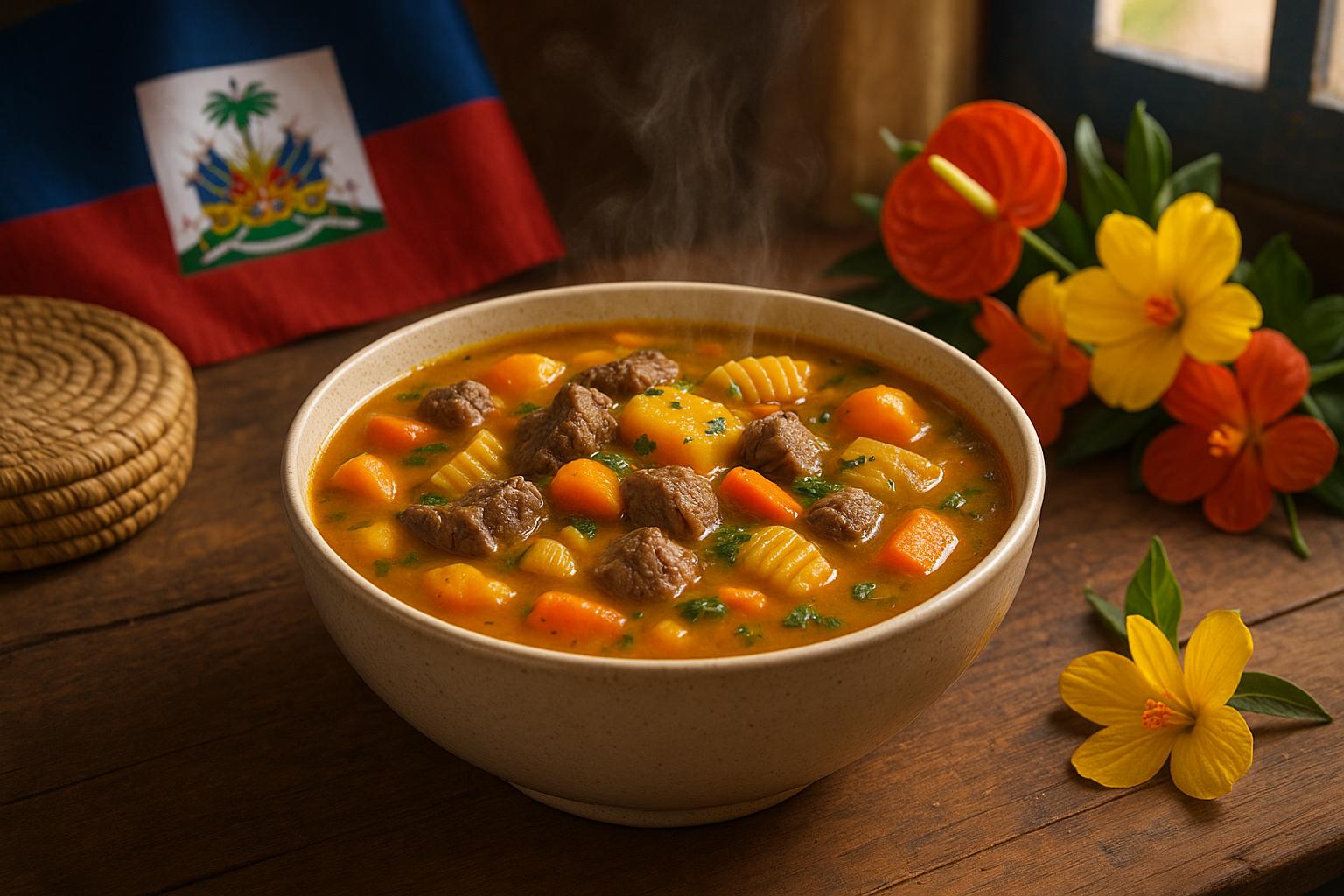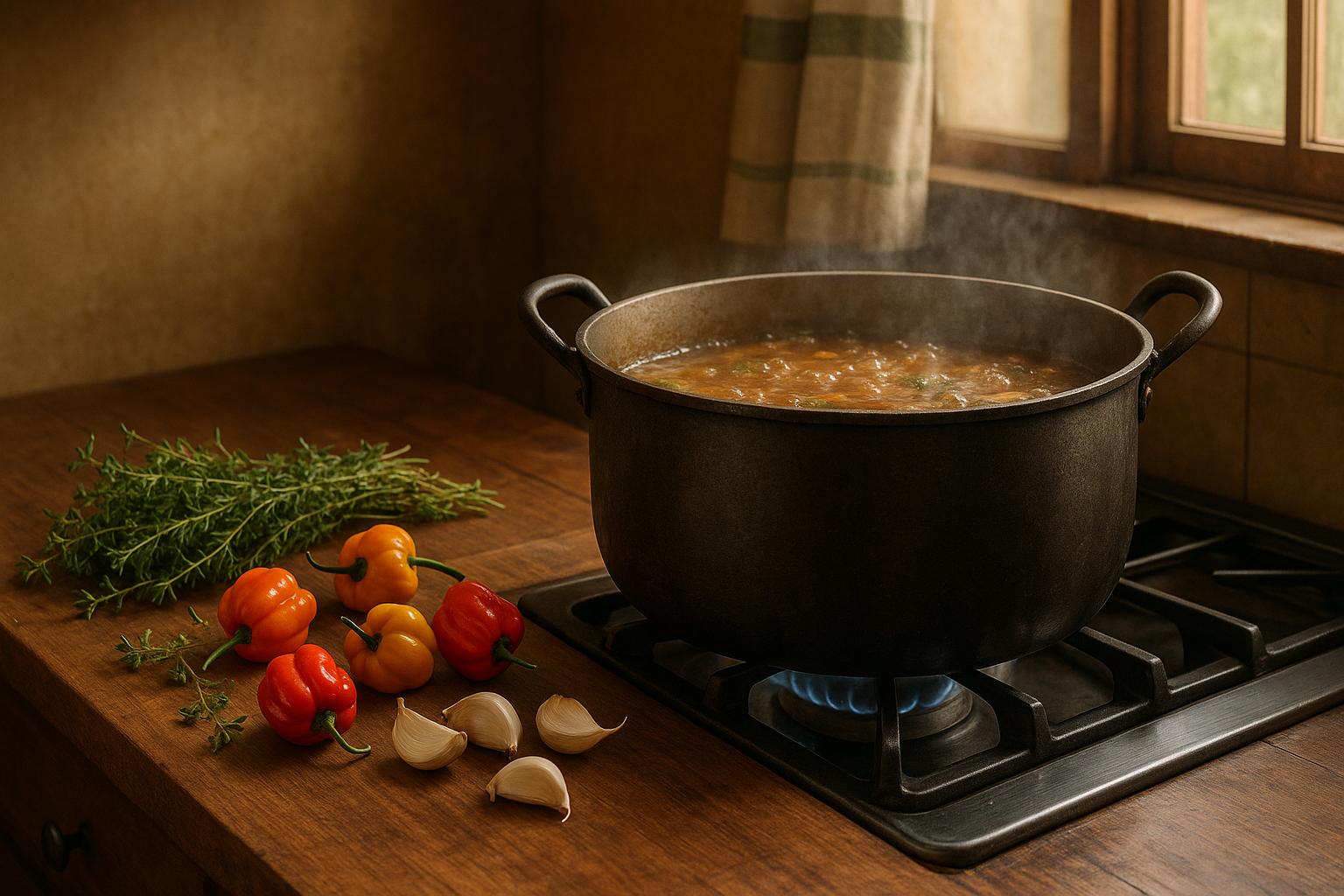Haitian street food, known as fritay, offers a vibrant mix of bold flavors and local traditions. From savory dishes like griyo (fried pork) with bannann peze (fried plantains) to sweet treats like dous makos and refreshing tropical juices, every bite reflects Haiti’s rich food scene. Key highlights include:
- Griyo & Bannann Peze: Pork marinated in epis (a spice blend) and paired with tangy pikliz.
- Pwason ak Bannann Peze: Fried fish with plantains, often served with spicy sauce ti-malice.
- Paté: Flaky pastries filled with seasoned meats or fish, perfect for on-the-go snacking.
- Sweet Treats & Drinks: Coconut-based desserts like tablet and creamy kremas with rum.
To enjoy safely:
- Choose vendors with high customer turnover and clean setups.
- Opt for hot, freshly cooked food and avoid questionable water or ice.
- Use small-denomination Haitian gourdes for smoother transactions.
Haitian street food showcases a blend of marinated meats, fried delights, and tropical flavors. Whether it’s a quick snack or a full meal, it’s a flavorful way to experience Haiti’s local cuisine.
Must-Try Haitian Street Foods
Griyo and Bannann Peze
Griyo (pronounced "gree-yo") is the undeniable star of Haitian street food. It's made by marinating pork in a flavorful blend called epis, which features garlic, thyme, parsley, and other spices. The pork is first boiled to tender perfection, then fried until it’s golden and crispy on the outside.
This dish is always paired with bannann peze, twice-fried plantains that are flattened and fried to achieve a perfect crunch. The sweet plantains balance the savory pork beautifully. To top it off, griyo is served with pikliz, a spicy, tangy pickled vegetable relish that cuts through the richness and adds a fiery kick.
Street vendors usually serve griyo in paper plates or small containers, making it easy to enjoy on the go. For many Haitians, this combination is more than just a meal - it’s a taste of home and a symbol of their culinary heritage. The same bold flavors can also be found in fish-based street dishes.
Pwason ak Bannann Peze
Pwason ak bannann peze is a lighter yet equally flavorful option. Vendors typically use fresh Caribbean fish like snapper or grouper, seasoning it with the same epis mix used for griyo. The fish is fried until its skin is golden and crispy, locking in its delicate flavors.
This dish also comes with twice-fried plantains, which provide a sweet balance to the savory fish. What makes this pairing special is the way the tender fish complements the plantains’ sweetness, offering a satisfying but less heavy alternative to pork.
For an extra burst of flavor, it’s often served with sauce ti-malice, a spicy hot sauce made with scotch bonnet peppers, onions, and lime juice. This sauce brings heat and tanginess, elevating every bite of this street food favorite.
Paté and Other Pastries
Paté (pronounced "pah-tay") is Haiti’s take on a meat-filled pastry, similar to an empanada. These flaky, golden pastries are stuffed with seasoned fillings like beef, chicken, or fish, along with diced onions, bell peppers, and a hint of tomato paste. The result? A savory snack that’s perfect for eating on the move.
Street vendors often keep paté warm in glass cases, ensuring they’re hot and ready throughout the day. The contrast between the buttery, crispy crust and the tender, flavorful filling makes them irresistible when eaten fresh.
Beyond paté, you’ll find other Haitian pastries worth trying. Chausson, for instance, uses a slightly different dough for a unique texture, while akra malanga offers something entirely different - crispy fritters made from grated malanga root mixed with herbs and spices. These fritters deliver an earthy flavor and a satisfying crunch, showcasing the depth of Haiti’s culinary traditions. And if you’ve got a sweet tooth, Haitian street vendors have plenty of options to satisfy.
Sweet Treats and Beverages
Haitian street food isn’t just about savory dishes. Kremas is a must-try drink that’s both indulgent and refreshing. Made with coconut milk, sweetened condensed milk, vanilla, and a splash of rum, this creamy beverage is served chilled in plastic cups - a perfect way to cool off after a spicy meal.
For dessert, there’s dous makos, a fudge-like treat made with coconut, condensed milk, and warming spices. These dense, sweet squares melt in your mouth and are often wrapped individually in wax paper, making them easy to carry or share.
Another classic is tablet, Haiti’s version of coconut candy. These small, chewy squares pack a punch of coconut flavor and are displayed in clear containers by street vendors. They may look simple, but their taste is rich and satisfying.
If you’re in the mood for something lighter, fresh jus (fruit juices) are a fantastic option. Vendors prepare juices from tropical fruits like mango, passion fruit, and soursop, blending them with ice for an instant refreshment. These natural, fruity drinks are the perfect way to round out a flavorful street food experience.
Tips for a Safe and Enjoyable Street Food Experience
Choosing the Right Vendors
A memorable street food experience starts with picking the right vendor. Look for stalls that are bustling with locals - it’s a strong sign that the food is fresh and in demand. Vendors with a steady stream of customers are more likely to have high turnover, meaning the food hasn’t been sitting out for long.
Pay attention to cleanliness, too. Covered food, separate utensils for raw and cooked items, and tidy workspaces are all promising signs. If you notice food sitting under heat lamps for extended periods, especially during peak hours (like 12:00–2:00 PM), it’s better to move on to another stall. Trust your instincts - if something looks or smells off, it’s best to skip it.
Hygiene and Food Safety
Keeping your hands clean is crucial. Always carry hand sanitizer and use it before and after meals.
Opt for foods that are thoroughly cooked and served hot, as high cooking temperatures help kill harmful bacteria. Popular dishes like griyo, fried fish, and paté are great choices since they’re usually prepared at high heat. Condiments like pikliz, a pickled vegetable relish, are generally safe due to their vinegar content, but it’s wise to avoid raw vegetables or salads unless you’re certain they’ve been washed properly.
For drinks, bottled water is your safest bet. Fresh fruit juices can be tempting, but make sure they’re made with clean water and ice. If you’re unsure about the ice’s safety, skip it altogether or stick to hot beverages like coffee.
Another tip: watch how vendors handle food and money. Reliable vendors often separate these tasks or wash their hands between handling cash and preparing food. This simple practice can go a long way in ensuring food safety.
Payment and Currency Tips
When buying street food in Haiti, cash is king. Vendors typically don’t accept credit cards, so it’s essential to carry cash with you. The Haitian gourde (HTG) is the official currency, but U.S. dollars are also widely accepted, especially in tourist hotspots like Cap-Haïtien and Jacmel [1].
For the best value, try to use small-denomination gourdes, as vendors often offer less favorable exchange rates for U.S. dollars. Having the right currency on hand ensures smoother transactions and helps you avoid unnecessary hassles while enjoying your meal.
Haitian Ingredients and Flavors
Key Ingredients
Haitian street food revolves around a handful of standout ingredients that define its character. Plantains are a staple, showing up in dishes like bannann boukannen (boiled green plantains) and bannann peze (twice-fried plantain slices). These are often paired with proteins such as griyo (fried pork) or freshly prepared fried fish.
Pork is a cornerstone of Haitian cuisine, especially in griyo, which features marinated, fried chunks of pork shoulder. This dish has become iconic in Haitian street food. Meanwhile, seafood takes center stage in coastal areas, where vendors serve up fresh fried fish and conch fritters, often made with same-day catches.
Rice and beans are a comforting and hearty base for many meals, with dishes like diri ak pwa (rice and beans cooked together) offering both nourishment and familiarity. To brighten the plate, there’s pikliz, a spicy pickled relish made with cabbage, carrots, and Scotch bonnet peppers. This condiment delivers a burst of heat and tang that’s hard to resist.
Fresh herbs are another essential part of the flavor palette. Parsley, thyme, scallions, garlic, and bell peppers are common, often blended into epis. This aromatic seasoning paste forms the backbone of countless Haitian dishes, infusing them with rich depth and complexity.
Common Flavors and Cooking Methods
Haitian cooks rely on traditional techniques to bring out bold, unforgettable flavors. Acidic marinades are key, with sour orange juice, lime juice, or vinegar used to tenderize meats and layer in bright, tangy notes. This method is especially prominent in dishes like griyo.
The backbone of many recipes is epis, a fragrant paste made from garlic, bell peppers, scallions, parsley, thyme, and Scotch bonnet peppers. Whether mixed into marinades or cooking sauces, epis delivers a flavor that is instantly recognizable as Haitian.
Scotch bonnet peppers bring the heat, adding a fiery kick along with subtle fruity undertones. Their influence is felt in everything from pikliz to meat marinades, where they balance spice with complexity.
Vendors often rely on frying to achieve the crispy textures and caramelized flavors that define dishes like bannann peze and griyo. Stewing is another favorite technique, allowing meats and vegetables to simmer slowly in seasoned broths, which enhances the flavors of epis and spices. To balance these rich, hearty elements, vinegar-based condiments provide a refreshing acidity.
Together, these ingredients and techniques create the signature profile of Haitian street food - bold, aromatic, and layered with heat, tang, and herbaceous notes that make every bite unforgettable.
Resources for Learning More About Haitian Cuisine
Explore HaitianFoods.org

Your adventure with Haitian street food is just the beginning. HaitianFoods.org is an excellent resource for diving deeper into the world of Haitian cuisine. This platform offers a global directory of Haitian restaurants, making it easy to keep exploring the flavors of Haiti, even after your trip. Whether you're in Miami, Fort Lauderdale, or anywhere else in the U.S., you can find spots serving iconic dishes like griyo, tassot, legume, and Conch Creole.
But it doesn’t stop at restaurant listings. HaitianFoods.org also features a detailed blog that delves into the essence of Haitian cuisine. From exploring traditional dishes to offering restaurant recommendations, the blog helps uncover the cultural stories behind the food you’ve enjoyed. It’s a great way to expand your appreciation for the rich culinary heritage of Haiti.
Take your love for Haitian cuisine to the next level by checking out all the resources available on HaitianFoods.org.
sbb-itb-80c33ff
How To Make Fritay – Cooking Delicious Haitian Food!
Conclusion
Haitian street food offers more than just delicious flavors - it’s a window into the rich history and traditions that shape Haiti. The blend of African, French, Spanish, and indigenous Taíno influences creates a culinary story that reflects the nation’s heritage and fosters a sense of community [2].
Whether it’s savoring griyo with bannann peze or chatting with a street vendor, each moment adds to a deeper cultural connection. Enjoying these cherished dishes means participating in traditions that have been lovingly passed down through generations.
As you explore, remember that small gestures like saying "Bonjour" or using Haitian Creole phrases like "Mesi" (thank you) can lead to meaningful interactions with locals [3]. These simple acts of kindness and curiosity can make your experience even more enriching.
With a respectful and open-minded approach, you’ll not only enjoy amazing food but also gain a deeper understanding of Haiti’s vibrant culture. Each bite becomes part of a shared story, leaving you with memories and insights that stay with you long after your journey ends [3].
FAQs
How can I safely enjoy Haitian street food as a first-time visitor?
To enjoy Haitian street food safely, start by picking vendors who cook food fresh on the spot - this helps lower the chances of contamination. Steer clear of raw or undercooked dishes, and be mindful of ice, as it might not always be made with purified water. Take a moment to assess the vendor’s setup, paying attention to the cleanliness of their stall, cooking tools, and overall hygiene.
Before digging in, wash your hands thoroughly with soap and water, or use hand sanitizer if that’s not an option. These simple precautions allow you to relish the bold and vibrant flavors of Haitian street food without compromising your health.
What’s the best way to communicate with Haitian street food vendors for a better experience?
To truly enjoy your experience with Haitian street food vendors, approach them with kindness and genuine curiosity. A warm smile and an interest in their dishes can help create a friendly connection.
If language becomes a challenge, don’t worry - simple words, hand gestures, or even a translation app can bridge the gap. Vendors often enjoy sharing details about their dishes and offering a glimpse into local life when they sense your excitement. By staying patient and open to the experience, you’ll not only savor the delicious flavors but also the vibrant culture behind Haitian cuisine.
What are the signature ingredients and flavors of Haitian street food, and what makes them so unique?
Haitian Street Food: A Flavorful Journey
Haitian street food is a celebration of bold, vibrant flavors and fresh, locally sourced ingredients. At its heart are dishes like griots - crispy, marinated pork bursting with savory goodness - and a variety of seafood and legumes, each seasoned to perfection with epis. This signature seasoning blend combines garlic, peppers, green onions, parsley, and thyme, creating a base that’s both aromatic and flavorful.
To elevate these dishes further, warm spices such as cloves and cinnamon add a layer of complexity, while pikliz, a tangy and spicy pickled vegetable relish, brings a zesty punch. The combination of these elements doesn’t just satisfy your taste buds; it tells a story of Haiti’s rich culinary traditions and the creativity of its street food culture.


